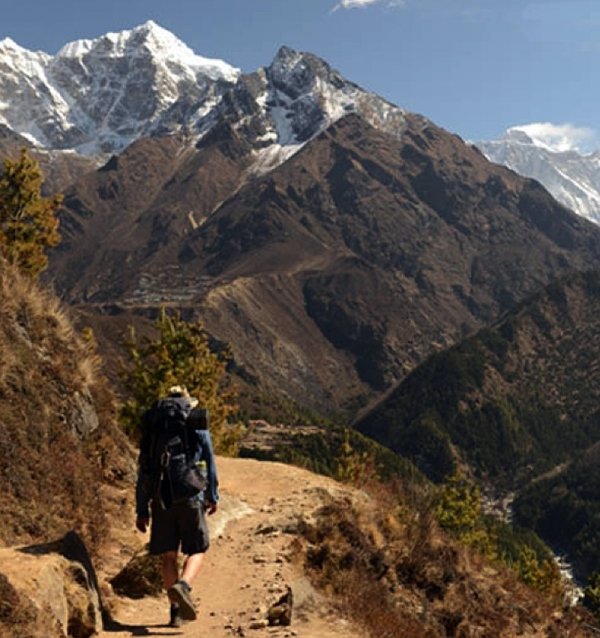 rekking to basecamp from Kala Patar. Everest at upper right. Photo courtesy of Dan Mazur.
rekking to basecamp from Kala Patar. Everest at upper right. Photo courtesy of Dan Mazur.
Climbing legend Dan Mazur spoke at Blend Wine Shop in Key Center March 30 at a fundraiser for The Longbranch Foundation, newly formed as a 501(c)(3) organization to support the preservation of the historic Longbranch Improvement Club. His parents, Bob and Mary Mazur, live in Longbranch.
Mazur has climbed or led climbing expeditions to Everest, K2, and other world famous peaks since the early 1990s, and was on his way back to Nepal when he spoke at Blend. "I'll be going to the mountain Saturday and will be there till June. It's where I work," he said.
But instead of regaling the audience with harrowing tales of conquering the most dangerous peaks in the world, or the time he saved a climber left for dead by his comrades, Mazur described the challenges facing ordinary Nepalese after the 2015 earthquake, the Sherpas who make the climbs possible, and the efforts to clean up decades of trash and human waste left on the slopes of Mount Everest.
The earthquake wrecked more in the remote villages than cities because of building techniques, said Mazur. Houses and schools are built from stacked stone because concrete and rebar to reinforce it are prohibitively expensive. "There are no roads, you've got to carry everything in," he said. "A bag of cement in Kathmandu might cost a few bucks, but that same bag in a village that's a two week trek away is $100."
Mazur's company, The Mount Everest Foundation for Sustainable Development, is supporting reconstruction efforts with treks to affected areas to deliver large rolls of plastic mesh used to reinforce new buildings. "All the building materials are there," he said, "they're just lying on the ground." Builders include a layer of rock-filled mesh every 3 feet or so in the walls of new structures to provide lateral stability.
Reconstruction is being done in conjunction with efforts to clean up the mountains. "The busy season on Everest is April and May, and there's no restriction on visitors," said Mazur. "Usually there's 1,000 people in base camp, including climbers and support." This is when Sherpas make money for their families for a year by assisting climbers, getting supplies up the mountain, and hauling trash down.
Nepal is the 12th poorest country in the world, and the number one killer there is diarrhea from contaminated water, said Garry Porter, a retired Boeing engineer and Everest veteran. As the environment has gradually warmed, the surrounding glaciers have retreated and human waste that no longer remains frozen is leaching into the water supply. "This place is sacred to them, and it's an environmental disaster," said Porter.
Sherpas carry 110-pound plastic "poop barrels" collected at base camp down the mountain to Gorak Shep, a remote village at 17,000 feet, where tons of waste have been dumped into unlined pits for decades. "The pathogens have contaminated their water supply,” said Porter, "and it's not just there, it's happening wherever there are lots of climbers."
Porter and other volunteer engineers have devised a solution: building an anaerobic digester to break down the waste and produce methane gas and sustainable fertilizer as a benefit. Digesters are in use all over the world, from Asia to Washington, D.C., but this one must meet engineering requirements unique to Gorak Shep. He said it must be built with local materials to reduce cost, use technology workable in Nepal, and be operated by the local population.
Porter's group, The Mount Everest Biogas Project, has partnered with Architects Without Borders and Engineers Without Borders to design a digester that can operate at the high altitude of Gorak Shep at a constant 80 degrees Fahrenheit. "Lower than that and the bacteria dies, and then you've got to clean up a big mess and start over," he said.
Solar panels and small-scale hydropower units available in Nepal can provide sufficient energy to simple resistance heaters in the digester, Porter said. "The methane produced is collected in a dome above the digester and can be piped straight to homes," he said, or stored in ordinary tire inner tubes for home use, a common practice in rural China.
The Mount Everest Biogas Project is collecting funds to finance the project now. Porter said they could break ground as early as 2017 and have the digester working soon after.
Mazur, who lives in Olympia with his wife and 4-year-old son, plans to quit Everest and stay home when his son starts school, though he may still climb in the Cascades. "I've got to figure that one out," he said.
For more information on Mazur's work in Nepal, go to:
summitclimb.com.
For more information on the Mount Everest Biogas Project, go to:
mteverestbiogasproject.org.
 rekking to basecamp from Kala Patar. Everest at upper right. Photo courtesy of Dan Mazur.
Climbing legend Dan Mazur spoke at Blend Wine Shop in Key Center March 30 at a fundraiser for The Longbranch Foundation, newly formed as a 501(c)(3) organization to support the preservation of the historic Longbranch Improvement Club. His parents, Bob and Mary Mazur, live in Longbranch.
rekking to basecamp from Kala Patar. Everest at upper right. Photo courtesy of Dan Mazur.
Climbing legend Dan Mazur spoke at Blend Wine Shop in Key Center March 30 at a fundraiser for The Longbranch Foundation, newly formed as a 501(c)(3) organization to support the preservation of the historic Longbranch Improvement Club. His parents, Bob and Mary Mazur, live in Longbranch.